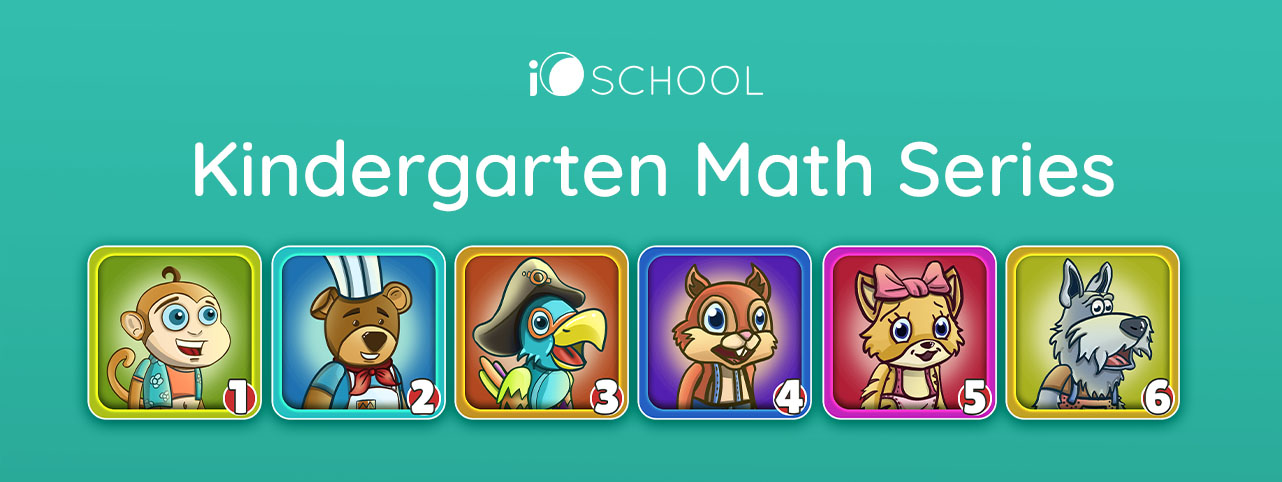Get in Touch
Follow Us!
Copyright © 2023 iO School, Inc. | All rights reserved | Privacy Policy | Terms and Conditions

Common Core Math Kinder Apps

Kindergarten Math: Saba
◆ Rote counting to 40
◆ Writing numbers 0 to 10
◆ Recognizing numbers 0 to 10
◆ Ordering numbers from smallest to largest 0 to 5
◆ Ordering numbers from largest to smallest 5 to 0
◆ Counting objects in lines or array 0 to 10
◆ Comparing objects and numbers 0 to 10
◆ Counting objects on a 10-frame
◆ Counting numbers 0 to 10
◆ Counting objects with one more 0 to 5
◆ Counting objects with one less 0 to 5
◆ Compare numbers greater than, less than and equal to 1 to 10
◆ Graphing numbers 0 to 10
Kindergarten Math: Mari
◆ Rote counting to 80
◆ Writing numbers 11 to 20
◆ Count objects in an array 0 to 20
◆ Counting objects on two 10-frames
◆ Ordering number symbols 0 to 10
◆ Ordering objects from least to greatest 1 to 10
◆ Ordering objects from greatest to least 10 to 1
◆ Comparing objects with smaller or larger and greater or fewer
◆ Ordering numbers symbols from least to greatest and from greatest to least (0-20)
◆ Comparing objects from smallest to largest and fewest to greatest
◆ Counting objects in a random array 11 to 20
◆ Comparing objects greater than, less than and equal to
◆ Comparing numbers greater than, less than and equal to
◆ Graphing objects in an array
◆ Ordering numbers starting from anything but the number 1
Kindergarten Math: Pat
◆ Rote counting to 120
◆ Writing numbers 11 to 20
◆ Counting objects in two 10-frames and random array
◆ Adding two sets of objects using “and/is”
◆ Compose numbers equal to 10
◆ Counting how many are left after removing objects from its group
◆ Adding two sets of objects using symbols
◆ Subtracting objects from its group using “take away/is”
◆ Subtracting two sets of objects using symbols
◆ Decomposing numbers within 10
◆ Addition problems with a sum of 10 or less
◆ Subtraction problems with a difference of 10 or less
Kindergarten Math: Joe
◆ Counting by 10’s to 100
◆ Adding numbers using symbols and words
◆ Subtracting numbers using symbols and words
◆ Addition word problems
◆ Subtraction word problems
◆ Compose numbers
◆ Decompose numbers
◆ Using a set of 10 ones and some further ones to compose numbers
◆ Using a set of 10 ones and some further ones to decompose numbers
◆ Adding two sets of objects using “and/is”
◆ Subtracting objects from its group using “take away/is”
◆ Using a set of random ones and some further ones to compose numbers
◆ Addition fluency practice
◆ Subtraction fluency practice
◆ Measure attributes of a single object
◆ Comparing height of objects
◆ Comparing length of objects
Kindergarten Math: Pearl
◆ Counting by 2’s and 5’s to 100
◆ Introduction to 2-dimensional shapes
◆ Naming 2-dimensional shapes with any size or orientation
◆ Describing shapes according to their positions
◆ Introduction to 3-dimensional shapes
◆ Identify whether a shape is 2-dimensional or 3-dimensional
◆ Counting and writing numbers practice
◆ Using smaller shapes to form bigger shapes
◆ Drawing 2-dimensional shapes
◆Identifying the number of sides and vertices in a 2-dimensional shape
◆ Identifying the number of sides and vertices in a 3-dimensional shape
Kindergarten Math: Clifton
◆ Arranging numbers starting from anything but 1
◆ Arranging numbers 1-20
◆ Counting and graphing objects in a random array
◆ Comparing objects using greater or fewer
◆ Comparing numbers greater than, less than and equal to
◆ Adding two sets of objects using “and/is”
◆ Subtracting objects from its group using “take away/is”
◆ Adding two sets of objects using symbols
◆ Subtracting two sets of objects using symbols
◆ Addition word problems
◆ Subtraction word problems
◆ Composing numbers
◆ Decomposing numbers
◆ Using a set of 10 ones and some further ones to compose numbers
◆ Using a set of 10 ones and some further ones to decompose numbers
◆ Comparing attributes of an object
◆ Using smaller shapes to form bigger shapes
◆ Describing shape positions
◆ Identifying the number of sides and vertices in a 2-dimensional shape
◆ Identifying the number of sides and vertices in a 3-dimensional shape
◆ Identifying 2-dimensional and 3-dimensional shapes
◆ Composing shapes from real-world objects
Copyright © 2023 iO School, Inc. | All rights reserved | Privacy Policy | Terms and Conditions